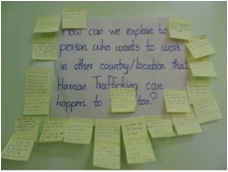This is my second year with Mrs. Yoda, and I was fortunate enough to go to Myanmar with CLinked. This year, we focused on educating a group of motivated and talented students who are becoming licensed teachers this fall. These students came from all over Myanmar, from bustling cities like Yangon to more rural areas such as Phyay. This group of students has been attending school in a church in Yangon under the care of Sister Grace. There, they have been able to receive education.
The lesson gave everyone the chance to understand the process of and how to prevent human trafficking. But more importantly, it enlightened the people in the room of the frighteningly ubiquitous nature of human trafficking, and how the myriad ways it can entice, damage and permanently debilitate someone’s livelihood. Human trafficking has been and still is a major problem in our world today. But what immediately shocked everyone in the room was how under-informed everyone is with regards to this crime. Compared to poverty, famine, and sanitation, human trafficking seems to fly under the radar for most people and governments. This is one of the reasons behind the terrible success of human trafficking.
At the beginning of the class, Ms. Junko showed the class a short film, introducing the effects of human trafficking. What struck most people right away was that people whom the victims knew and trusted had led all the victims of human trafficking into the trade. Afterwards, she presented a PowerPoint that gave crucial information on how to spot human trafficking, the causes of human trafficking, the 7 roles in such a transaction and also how to reduce the chance of you being trafficked. During the process, she also covered the Law of Myanmar. To my surprise, the students were unfamiliar with some very basic laws. This showed many men and women across the country are in a vulnerable state as they are innocent to their surroundings regarding the issue of human trafficking.
As the first session came to an end, the bell rang and everyone stood up and left. Not knowing where to go or what to do, I was very confused, but a few girls from the class came to me and brought me to the kitchen. It was lunchtime! As their guest, we were treated with the utmost kindness. We were treated with their local vegetables and meat, along with the delicious fish balls infused in chili sauce. Before I could catch my breath, I was rushed back to the classroom with the rest of the class, to prepare for a skit. The class was divided into 3 groups, one to focus on the migration aspect in human trafficking, one to raise awareness and one to show the betrayal of trusted family and friends. Between these three skits, we were able to demonstrate the consequences of being trafficked and learn how to prevent such a situation from happening. At the end of the session, Ms Junko asked the class what is their next step moving forward. Most of them said after graduating, they will return to their own city and hope to raise awareness of human trafficking, provide education for the local children but also teach them the knowledge of human trafficking with the hope of reducing the trafficking rate. Others replied similarly. They also said that even though they may not have the power to rescue others, they are now able to protect themselves.
Before we had to leave, the students bade us goodbye with a farewell song. It wasn’t only beautifully sung but also touching, and it gave me a moment to reflect on the few hours we spent together. They had welcomed me from the moment I stepped in and had not treated me differently, but as one of their own. For this, I am grateful to have met a group of such wonderful people. I believe that they will become great teachers in their own right and hopefully I will see them again in the near future.
Although the predominant purpose of the session was to teach the teacher trainees, it was an enriching experience for myself as well. The session gave me an even deeper scope to human trafficking. I have always known that human trafficking is a problem, but this session revealed to me the true scale of the threat we all face. It has also imbued me with a greater resolve to learn more and to contribute as much as possible in the fight with human trafficking. I am confident that while my contributions may not be much initially in the grand scheme of things, but with the help of Clinked, if we can save just one more person from human trafficking, that is one more victory against this injustice. And that is why I love being part of Clinked. They are working to make things happen, for each and every child, one child at a time.
















































